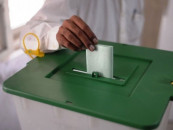The perils of hiking in Margalla hills

The perils of hiking in Margalla hills
Snakes of various kinds can be found in the hills and it is important to know what one must do in the event of a bite. Chief Biological production region, National Institute of Health (NIH) Abdul Samad says that the bite can be instantly recognised as being poisonous or non-poisonous. “A nonpoisonous snake bite will leave the imprint of broad denture on the skin whereas a bite from a poisonous snake will leave two dot-like bleeding imprints of a fang-bite,” he said.
Abdul added the snakes in the Margalla are poisonous and it can take anywhere between 20 minutes to two hours for the poison to affect the human body. Anti-snake serum is available at hospitals in the capital and should be administered as soon as possible after a snake bite. Cobra (Naja Naja), Krait (Bungarus caeruleus), Russell’s viper (Viper russelli), Saw scaled viper (Echis carinatus) snakes are a threat to the hikers of the Margalla hills. He said “the bite fraction might go away in seconds but mostly people have a deeper psychological impact of the bite and that confusion might lead to them not knowing what to do.” He further said “There were times when there were constant demands for Anti-Snake Serum, NIH supplies 30-40 thousand Vile per year throughout Pakistan.
Dr Anis Kausar Additional Executive Director Poly Clinic Hospital said, “We get our aniti- snake bite serum from NIH on a monthly basis and the demand rises during the monsoon season. He said that over the years, the cases of snake bites had decreased gradually. The reason for this is believed to be the reduction of greenery due to construction on the hills. Abdul Samad said that construction had forced snakes along with other wildlife to either migrate or die due to their changing habitat. He further said that the hills had now come to look artificial. Rasheed has been caretaker at Trail 5 Hiking track of the Margalla hills, for six months not.
He said, “I have spotted snakes but no snake-bite casualty has been reported ever since I have joined.” He added “If the snake bite is poisonous we are to give them immediate first aid on the spot, we will cut the flesh with a blade and then tie the affected area with a cloth. This slows the spread of poison as we rush them to the hospital where they are further treated. According to a report by Biological Production Division National Institute of Health Islamabad, steps taken after the snake bite include; the assessment of a symptoms. If a puncture oozing with blood, discoloration of the skin and swelling are observed, it is termed poisonous.
In this case the blood flow from the bitten area should be slowed and antivenom serum administered as soon as possible. The patient should move as little as possible and if in shock, treat with cardiopulmonary resuscitation. In case of bites on limbs, apply a pressure bandage to control flow of blood and lymph from the area of the bite.
Partially release the pressure bandage after every 10 minutes. In the management of snakebites clinical and laboratory investigations include: pulse, blood pressure and respiratory rate should be monitored on half hourly basis. Body temperature, urine out should be analyzed. Diameter of bitten limb and estimation of proximal spread should be monitored. Neurological assessment should be carried out i.e check the level of consciousness and reflexes.
Poisonous snakes of Margalla Hills
According to a Publication by Zahid Baig Mirza a biodiversity expert with 50 years of Field research experience on vertebrate fauna of Pakistan said the venomous snakes existing in national park Margala hills are Cobra, Krait, and Vipers.
Cobra (Naja naja)
• The Cobra has an average length of five to six feet.
• It spreads its hood when excited or frightened.
• It is more active at night.
• Its venom causes a neurotoxic reaction which slows breathing and heart rate. Symptoms begin anywhere from eight minutes to two hours after being bitten. The bite can be fatal if it is not treated immediately.
Russell’s viper
• It has an average length of five feet.
• It is mostly active at night . Mirza describes the hissing sound it makes when provoked as “frightening”.
• Symptoms include pain followed by swelling of the affected area. Bleeding is common after the bite. Death may occur one to 14 days after the bite, if not treated properly.
Saw-scaled Viper
• Identified by an arrow-shaped mark on the head.
• When excited, it produces a loud sizzling sound by rubbing its coils together
• Its venom is more toxic than the Cobra or Russell viper’s
• Causes more deaths than any other type of snake
• Reaction to the poison causes internal bleeding which may last days or even weeks.
Krait (Bungarus caeruleus)
• Average length 3 feet
• Characterised by glossy, dark brown or black skin with white streaks
• Nocturnal
• It is many times more poisonous than the Cobra or the Viper.
• The bite is extremely neurotoxic and muscle paralysis sets in very quickly.
• As the respiratory muscles become paralysed, the victim will eventually suffocate unless treated with an antidote.
• The victim may also be treated by an artificial respirator until the body metabolises the venom.
Published in the Express Tribune, May 22nd, 2010.



















COMMENTS
Comments are moderated and generally will be posted if they are on-topic and not abusive.
For more information, please see our Comments FAQ